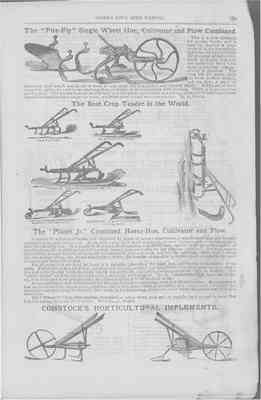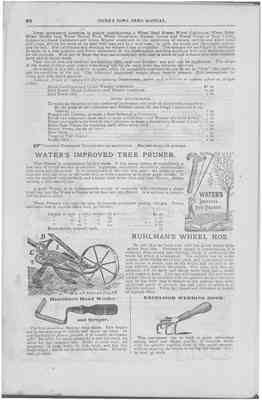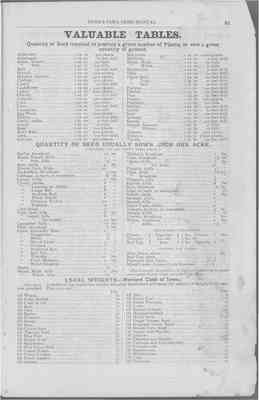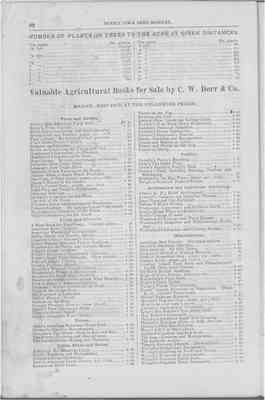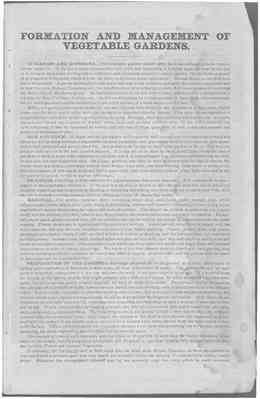Pages
61
Dorr's Iowa Seed Manual. ... 59
The "Fire-Fly" Single Wheel Hoe, Cultivator and Plow Combined. [Image: Drawing/Scratchboard illustration of the "Firefly" Single Wheel Hoe, Cultivator and Plow.] This is a new claimant for public favor, and is sure to receive a large share of it, for it combines lightness and strength with the greatest adjustability while its highly polished and tempered steel tools make gardening comparatively a pleasure. The tools are all made after the most perfect models and the first, a pair of admirable hoes which can be set to work to and from the row and to any desired depth. Next a set of three reversible cultivator teeth to be used together, or singly, or in conjunction with the hoes. Third, a large excellent garden plow. The handle is made of stiff iron, and the whole tool is light and strong, attractive in appearance and capable of standing hard usage for years, whle the price is final recommendation. $4.50, boxed.
The Best Crop Tender in the World. [Images: 6 Drawings/Scratchboard Illustrations of the Planet Jr. plow with different blades attached. Captions for 5: As a Cultivator, As a Furrower or Hiller, "Planet Jr." Horse Hoe, Cultivator, etc., etc., As a Coverer, with Roller, As a Coverer, with Leveling and Pulverising Rake.]
The "Planet Jr." Combined Horse-Hoe, Cultivator and Plow. Invented by a practical farmer and improved by years of patient experiment, it stands unrivaled and beyond competition by any similar tool. Made with extra high steel standards, at once stronger and more satisfactory than the old style iron. It is excellent in design, workmanship and finish, and capable of the greatest number of combinations, all of which are useful to every farmer, and admirable for the purpose intended. Thc tool, except the handles, is made entirely of wrought and malleable iron and steel, and has the standing clevis with locking pin, the stirrup clamp, the frame adjustable in width, the handles changeable in height, teeth adjustable to depth or angle, and reversible points.
For all crops that are hoed by hand it is valuable, preceding the hand hoe, and saving three-fourths of the work. For all crops that are hilled, and very few are not, nothing can exceed the perfection and ease with which and this tool performs the work, breaking up the soil perfectly, and hilling the crop much or little as desired. For "level culture" so desirable for some soils, it is equally well adapted. Every complete machine has a set of fine 1-1/4 inch teeth and a set of eight other attachments adapted to all kinds of work.
As an opening plow it is invaluable for making furrows for potatoes, corn and all other crops. As a coverer it has no equal for corn, broom-corn, potatoes, and in fact, every kind of covering, as it covers and rolls down the ground at one operation, in ordinary field work, or fits for setting out plants or for using the garden seed drill and wheel hoe.
The "Planet Jr." has, from its first introduction taken front rank and so rapidly has it gained in favor that it is fast taking the place of all others. Price $16.00, boxed.
Comstock's Horticultural Implements. [Image: Drawing/Scratchboard illustrations of two of the plows.]
62
60. ... Dorr's Iowa Seed Manual.
These implements comprise, in simple combinations, a wheel Seed Sower, Wheel Cultivator, Wheel Rake, Wheel Shuffle Hoe Wheel Shovel Plow, Wheel Strawberry Runner Cutter and Wheel Verge or Turf Cutter, Comstock's Hand Cultivator and Onion Weeder combined, in the cultivation of onions, carrots and other small drill crops, will do the work of six men with hoes and do it with ease. It pulls the weeds and thoroughly pulverizes the soil. For cultivation and weeding we believe it has no superior. The changes for each kind of work can be made in a few minutes, and every implement of the combination machine works as well as if made specially for the purpose. With any of them one man can accomplish with ease as much as half a dozen men with common tools and do better work. They are all iron and steel but the handles, light, neat and durable; any part can be duplicated. The shape of the frame protects large plants from being torn by the teeth when run between the rows. As a seeder it is a very positive dropper, while its adjustable shoe-coverer can be set to "firm" the earth to suit the condition of the soil. The combined implement weighs about twenty pounds. Full instructions for using sent with every machine. Reduced Prices of Comstock's Horticultural Implements, boxed and delivered at express offices or freight depots.
Hand Cultivator and Onion Weeder combined. ... $6 00 Seed Sower, Hand Cultivator and Weeder combined. ... 10 50 Seed Sower only. ... 7 00 Extra Attachments. To make up the price of any combined implement add price of attachment wanted to $6, the price of the Cultivator and Weeder-thus, for the Verge Cutter add $1.25, making. ... 7 25 Hopper and Coverer, to make a Seed Sower of a Cultivator. ... 5 00 Set of two rakes and three teeth to make a Cultivator and Weeder of a Seed Sower. ... 3 75 Wheel and knife to be fixed to the Cultivator to make a Strawberry Runner Cutter. ... 2 00 Extra Steel Plates, for replating teeth when worn, each. ... 17 Shovel Plows, the set of three. ... 1 50 Mole Plow. ... 75 Verge or Turf Cutter. ... 1 25 Scuffle Hoe. ... 1 25 [Image: icon of pointing finger.] Complete Illustrated Circular sent on application. Enclose stamp for postage.
Water's Improved Tree Pruner. This Pruner is unsurpassed by any made. It has many points of superiority, a few only of which we will enumerate: Lightness, simplicity, durability, interchangeable parts and cheapness. It is constructed of the very best steel; the blade is constructed with the lever at the lower end, in such a manner as to give great power. It cuts the smallest twig perfectly and a larger limb better than any other Pruner, always making a very smooth cut. A good Pruner is an indispensable article to everyone who cultivates a single fruit tree, and the Water's Pruner is the best one yet offered. It is without a competitor for public favor.
These Pruners can only be sent by express, purchaser paying charges. Prices, delivered free at express office here, as follows:
Length of pole- 4 feet; weight 2-1/4 pounds. ... $2 00 " " 6 " " 2-3/4 " . ... 2 25 " " 8 " " 3-1/2 " . ... 2 50 " " 10 " " 4-1/4 " . ... 2 75 Extra knives, prepaid, each. ... 35 [Image: Drawing/Scratchboard illustration of a person using a tree pruner to trim branches high in a tree, Caption-Waters Improved Tree Pruner.]
[Image: Drawing/Scratchboard illustration of a wheel hoe and various parts, J.F. Sullivan Enq. N.Y.]
RUHLMAN'S WHEEL HOE. No tool that we have ever sold has given better satisfaction than this. Extremely simple in construction, it is compact, firm, strong and durable, doing to perfection the work for which it is designed. The handles can he raised to suit , knife blades set to any pitch, and from seven to sixteen inches in width; can be run within half an inch of the row without injury to tbe plants. One man, with this implement, will do more and better work than half a dozen with common hoes. This fact will commend this tool to the farmer who is so crowded with the general work of the farm that he has little time to bestow on the garden-that little, neglected patch of ground, the real value of which is so slightly realized. Price, $5; boxed and delivered at freight or express office.
[Image: Drawing/Scratchboard illustration of a hand weeder.] Haseltine's Hand Weeder and Scraper.
The first practical Weeder ever made. One hour's use in strawberries or onions will repay its costs. In any vegetable or flower garden it is simply indispensable. Its price, (50 cents, prepaid,) is not one-tenth its value for one season's use. Blade is solid steel, oil tempered, 7/8 inch wide;. 1/8 inch thick, and has five sharp edges; above cut is one-sixth full size. Price by mail, 50cents.
[Image: Drawing/Scratchboard illustration of a weeding hook.] Excelsior Weeding Hook. This instrument can be used to great advantage among small and tender plants. It removes weeds with far greater rapidity than in the usual manner without injuring the plants or soiling the hands. Price by mail, 35 cents.
63
Dorr's Iowa Seed Manual. ... 61
Valuable Tables. Quantity of Seed required to produce a given number of Plants, or sow a given quantity of ground. [Left column] Artichoke. ... 1 oz. to 500 plants Asparagus. ... 1 oz. to 60 feet drill. Beans, Dwarf. ... 1 qt. to 300 hills. " Pole. ... 1 qt. to 200 hills. Beet. ... 1 oz. to 150 feet drill. Brocoli. ... 1 oz. to 3000 plants. Brussels Sprouts. ... 1 oz. to 3000 plants. Cabbage. ... 1 oz. to 3000 plants. Carrot. ... 1 oz. to 150 feet drill. Cauliflower. ... 1 oz. to 3000 plants Celery. ... 1 oz. to 8000 plants. Chicory. ... 1 oz. to 100 feet drill. Collards. ... 1 oz. to 3000 plants. Corn. ... 1 qt. to 400 hills. Cress. ... 1 oz. to 100 feet drill. Cucumber. ... 1 oz. to 200 hills. Egg Plant. ... 1 oz. to 2000 plants. Endive. ... 1 oz. to 150 feet drill. Garlic, bulbs. ... 1 lb. to 10 feet drill. Gourd. ... 1 oz. to 50 hills. Kale. ... 1 oz. to 3000 plants. Kohl Rabi. ... 1 oz. to 3000 plants. Leek. ... 1 oz. to 150 feet drill. Lettuce. ... 1 oz. to 5000 plants. [Right Column] Marjoram. ... 1 oz. to 10,000 plants. Martynia. ... 1 oz. to 30 feet drill. Melon, Musk. ... 1 oz. to 150 hills. " Water. ... 1 oz. to 50 hills. Nasturtium. ... 1 oz. to 30 feet drill. Okra. ... 1 oz. to 50 feet drill. Onion Seed. ... 1 oz. to 100 feet drill. " Tops. ... 1 qt. to 20 feet drill. " Sets. ... 1 qt. to 20 feet drill. Parsnip. ... 1 oz. to 200 feet drill. Parsley. ... 1 oz. to 150 feet drill. Peas. ... 1 qt. to 150 feet drill. Pepper. ... 1 oz. 2000 plants. Pumpkin. ... 1 qt. to 200 hills. Radish. ... 1 oz. to 100 feet drill. Salsify. ... 1 oz. to 80 feet drill. Sage. ... 1 oz. to 200 feet drill. Spinage. ... 1 oz. to 100 feet drill. Savory. ... 1 oz. to 300 feet drill. Squash, Summer. ... 1 oz. to 50 hills. " Winter. ... 1 oz. to 10 hills. Tomato. ... 1 oz. to 5000 plants Tobacco. ... 1 oz. to 10,000 plants. Turnip. ... 1 oz. to 150 feet drill.
Quantity of Seed Usually Sown Upon One Acre. (Provided you use Dorr's Iowa Seeds.) [Left Column] Barley, broadcast. ... 2-1/2 bu. Beans, Dwarf, drills. ... 1 ". " , Pole, hills. ... 1/4 ". Beet, drills. ... 4 lbs. Broom Corn, drills, ... 10 " Buckwheat, broadcast. ... 3/4 bu. Cabbage, in beds, to transplant. ... 1/4 lb. Carrot, drills. ... 2 lbs. Clover, Alsike. ... 6 " " Lucerne, or Alfalfa. ... 8 " " Large Red. ... 8 " " Medium red. ... 8 " " White Dutch. ... 6 " " Crimson Trefoil. ... 10 " " Bokhara. ... 4 " Corn Salad. ... 5 " Corn, field, hills. ... 6 qts. " sweet, hills. ... 8 " " " , for fodder. ... 2-1/2 bu. Cucumber, hills. ... 1-1/2 lbs. Flax, broadcast. ... 1/2 bu. Grass, Kentucky blue. ... 2 " " Hungarian. ... 1/2 " " Millet. ... 1/2 " " Mixed Lawn. ... 3 " " Orchard. ... 2 " " Perennial Rye. ... 2 " " Red Top. ... 2 " " Timothy. ... 12 lbs. " Fowl Meadow. ... 2 bu. " Wood Meadow. ... 2 bu. Hemp. ... 1/2 " Melon, Musk, hills. ... 2 lbs. " Water, hills. ... 1-1/2 " [Right column] Mustard, broadcast. ... 6 lbs. Oats, broadcast. ... 2-1/2 bu. Onion, drills. ... 5 lbs. " " for sets. ... 30 " Parsnip, drills. ... 5 " Peas, drills. ... 1-1/2 bu. " broadcast. ... 3 " Potatoes, hills. ... 8 " Radish, drills. ... 8 lbs. Rye, broadcast. ... 1-1/2 bu. Sage, in beds, to transplant. ... 1 lb. Salsify, drills. ... 8 lbs. Spinage, drills. ... 10 " Squash, hills. ... 2 " Sugar Cane, drills. ... 10 " Tomato, in beds, to transplant. ... 2 " Turnip, drills. ... 1 lb. Vetches, broadcast. ... 2 lbs. Wheat, broadcast. ... 2 lbs. " , drills. ... 1-1/2 " Grass Seed, For Mowing. Clover. ... Together for one acre ... 5 lbs. Clover. 6 lbs. Timothy. ... " ... 5 lbs. or Red Top. ... " ... 7 lbs. Timothy. 6 " Grasses, For Lawns. Blue Grass, alone. ... 3 bu. Red top, alone. ... 3 " Perennial Rye Grass. ... 3 " Mixed Lawn, Central Park Mixture. .. 6 " Much larger quantities of Seed are required to make an elegant lawn, than for other purposes.
Legal Weights - (Revised Code of Iowa. ) Sec. 2049. A bushel of the respective articles hereafter mentioned will mean the amount of weight in this section specified: That is to say: [Left Column] ... ... Lbs. Of Wheat. ... 60 Of Corn, shelled. ... 56 Of Corn in cob. ... 70 Of Rye. ... 56 Of Oats. ... 32 Of Barley. ... 48 Of Potatoes. ... 60 Of Beans. ... 60 Of Bran. ... 20 Of Clover Seed. ... 60 Of Timothy Seed. ... 45 Of Flax Seed. ... 56 Of Hemp Seed. ... 44 Of Buckwheat. ... 52 Of Blue Grass Seed. ... 14 Of Castor Beans. ... 46 Of Dried Peaches. ... 33 Of Dried Apples. ... 24 Of Onions. ... 57 [Right Column] ... Lbs. Of Salt. ... 50 Of Stone Coal. ... 8-0 Of Sweet Potatoes. ... 46 Of Lime. ... 80 Of Bushel of Sand. ... 130 Of Hungarian Seed. ... 48 Of Millet Seed. ... 48 Of Osage Orange Seed. ... 32 Of Sorghum Sacch, Seed. ... 30 Of Broom Corn Seed. ... 30 Of Apples and Peaches. ... 48 Of Quinces. ... 48 Of Cherries and Grapes. ... 40 Of Currants and Gooseberries. ... 40 Of Strawberries. ... 32 Of Raspberries. ... 32 Of Blackberries. ... 32 Of Coke. ... 38 Of Charcoal. ... 20
64
63 ... Dorr's Iowa Seed Manual.
Number of Plants of Trees to the Acre at Given Distances. [table] [column headings: Dis. apart.; No. plants.] 1/2 foot. 174,240. [1/2 foot]. 43, 560. 1-1/2 feet. 19,360. 1 [feet]. 10,800. 2-1/2 [feet]. 6,969. 2 [feet]. 4,840. 3 [feet]. 2,722. 4 [feet]. 1,742. 5 [feet]. 1,210. 6 [feet]. 889. 7. 8 feet. 680. 9 [feet]. 573. 10 [feet]. 435. 11 [feet]. 360. 12 [feet]. 302. 15 [feet]. 108. 18 [feet]. 134. 20 [feet]. 100. 25 [feet]. 69. 30 [feet]. 49.
Valuable Agricultural Books for Sale by C. W. Dorr & Co. Mailed, Post-Paid at the Following Prices: [Right Column] Farm and Garden. Allen's New American Farm Book. ... $2 50 Barry's Fruit Garden. ... 2 50 Brill's Farm Gardening and Seed Growing. ... 1 00 Broom-Corn and Brooms; paper, 50c; cloth. ... 75 Flax Culture. My seven practical growers. ... 30 Fitz's Sweet Potato Culture. ... 40 Gregory on Squashes. ... 30 Harris on Gardening for Young and Old. ... 1 25 Henderson's Gardening for Pleasure. ... 1 50 Henderson's Gardening for Profit. ... 1 50 Hop Culture. By nine experienced cultivators. ... 30 Johnson's How Crops Feed. ... 2 00 Johnson's How Crops Grow. ... 2 00 Oemler's Truck Farming at the South. ... 1 50 Onions-How to Raise Them Profitably. ... 20 Our Farm of Four Acres; paper, 30c; cloth. ... 60 Quinn's Money in the Garden. ... 1 50 Riley's Potato Pests; paper, 50c; cloth. ... 75 Roe's Play and Profit in My Garden. ... 1 50 Silos and Ensilage. ... 50 Stewart's Irrigation for the Farm. ... 1 50 The Soil of the Farm. ... 1 00 Thomas's Farm Implements and Machinery. ... 1 50 Tobacco Culture. By 14 experienced Cultivators. ... 25 Warrington's Chemistry of the Farm. ... 1 00 White's Gardening for the South. ... 2 00
Fruits and Flowers. A Fern Book for Everybody. Colored plates. ... 50 American Rose Culturist. ... 30 American Weeds and Useful plants. ... 1 75 Bulbs, Hardy and Tender, (Rand). ... 1 75 Charlton's Grape Grower's Guide. ... 75 Every Woman Her own Flower Gardener. ... 1 00 Flowers for the Parlor and Garden, (Rand). ... 1 75 Fuller's Grape Culturist. ... 1 50 Fuller's Illustrated Strawberry Culturist. ... 20 Fuller's Small Fruit Culturist. (New edition) .... 1 50 Fulton's Peach Culture. ... 1 50 Garden Flowers, (Rand). ... 1 75 Henrich's Window Flower Garden. ... 75 Henderson's Practical Floriculture. ... 1 50 Henderson's Hand-Book of plants. ... 3 00 Husmann's Grape Growing and Wine Making. ... 1 50 How to Destroy Insects (complete). ... 30 Johnsons's Winter Greeneries at Home. ... 1 50 Mohr on the Grape Vine. ... 1 00 My Vineyard at Lakeview. ... 1 25 Orchid Manual, (Rand). ... 2 00 Parsons on the Rose. ... 1 50 Popular Flowers, How to Grow (Rand). ... 1 50 Quinn's Pear Culture for Profit. ... 1 00 Rhododendrons (Rand). ... 1 25 River's Miniature Fruit Garden. ... 1 00
Horses. Dadd's American Reformed Horse Book. ... 2 50 Herbert's Hints to Horsekeepers. ... 1 75 Howden's, The Horse-How to Buy and sell. ... 1 00 The Horse-Varieties and Management. ... 75 The Saddle Horse-Riding and Training. ... 1 00 Cattle, Sheep and Swine. Alien's (L.F.) American Cattle. ... 2 50 Cattle-Varieties and Management. ... 75 Coburn's Swine Husbandry. ... 1 75 Dadd's American Cattle Doctor, 8vo. cloth. ... 2 50 Guenon on Milch Cows. ... 1 00 [Left Column] Harris on the Pig. ... $1 50 Keeping one Cow. ... 1 00 Quincy (Hon. Josiah ) on Soiling Cattle. ... 1 25 Randall's Fine Wool Sheep Husbandry. ... 1 00 Randall's Practical Shepherd. ... 2 00 Randall's Sheep Husbandry. ... 1 50 Stewart's Shepherd's Manual. ... 1 50 Sheep-Varieties and Management. ... 75 Youatt and Martin on Cattle. ... 1 50 Youatt and Martin on the Hog. ... 1 00 Youatt on Sheep. ... 1 00
Poultry. Geyelin's Poultry-Breeding. ... 1 25 Gray's The Game Fowl. ... 1 50 Lewis's Practical Poultry Book. ... 1 50 Poultry-Their Breeding Rearing, Feeding and Exhibiting. ... 50 Stoddard's, An Egg Farm; paper, 50c; cloth. ... 75 Wright's Practical Poultry Keeper. ... 2 00
Architecture and Landscape Gardening. Allen's (L. F.) Rural Architecture. ... 1 50 Atwood's Country and Suburban Houses. ... 1 50 Barn Plans and Out-Buildings. ... 1 50 Palliser's Model Homes. ... 1 00 Plummers', Carpenters' and Builders Guide. ... 1 00 Reed's House Plans for Everybody. ... 1 50 Reed's Cottage Houses. ... 1 25 Woodward's Cottage and Farm Houses. ... 1 00 Woodward's Graperies and Horticultural Buildings. ... 1 00 Woodward's Suburban and Country Houses. ... 1 00
Miscellaneous. American Bird Fancier. (Enlarged edition. ... 50 Arnold's American Dairying. ... 150 Bird-keeping. By Miss Dyson. ... 150 Bommer's Method of Making Manures. ... 25 Book of Household Pets: paper, 50c; cloth. ... 75 Canary Birds: paper. 50c; cloth. ... 75 Cooking School Text Book and Housekeepers' Guide, (Miss Juliet Corson). ... 1 25 De Voe's Market Assistant. ... 2 50 Dogs of Great Britain, America, etc. ... 2 00 Everybody's Paint Book. ... 1 00 Fisher's Grain Tables. ... 40 Fuller's Forest Tree Culturist. ... 1 00 Harris' Insects Injurious to Vegetation. Plain, $4.00; Colored Engravings. ... 6 50 Harris' Talks on Manures. ... 1 75 Hooper's Dog and Gun; paper, 30c; cloth. ... 60 How to be your own Lawyer. ... 1 50 Johnson's Agricultural Chemistry. ... 1 75 King's Bee-Keeper's Text Book, cloth. ... 1 00 Mrs. Elliott's Housewife. ... 1 25 Murphy's American Game Bird Shooting. ... 2 00 Prescott's Practical Hints on Rifle Practice. ... 50 Quinby's New Bee-Keeping. ... 1 50 Root's ABC of Bee Culture. ... 1 25 Scribner's Lumber and Log Book. ... 35 The Dog-Varieties and Management. ... 50 The Scientific Angler. ... 1 50 Twenty-five cent Dinners. (New edition). ... 25 Warder's Hedges and Evergreens. ... 1 50 Waring's Draining for Profit and Health. ... 1 50 Waring's Elements of Agriculture. ... 1 00 Willard's Practical Butter Book. ... 1 00 Willard's Practical Dairy Husbandry. ... 3 00
65
Formation and Management of Vegetable Gardens.
SITUATION AND EXPOSURE.-The vegetable garden should never be in an orchard, or have trees or scrubs within it. If the space must accommodate both fruit and vegetables, it is better to set the fruit at one end so as to leave the portion for vegetables unbroken and unshaded, even if it is much smaller. On the farm, it should be so placed as to be easily reached from the barn, to facilitate horse cultivation. Abrupt slopes in any direction are to be avoided A gentle inclination to the south and east is the warmest, will give the earliest vegetables and be best for Corn, Melons, Tomatoes, etc., but it suffers more from a Spring or early Fall frost, because of receiving the direct rays of the morning sun. An inclination to the north and west is later, suffers less in a drought,and is the best for Peas, Cabbage, Luttuce [lettuce], etc. So it is an advantage in a large garden, to have both these exposures, but for small gardens a gentle inclination to the south or east, or a level surface, is the best.
SOIL.-A good garden can be made on any soil, but that best suited to the purpose, is a deep, rich, friable loam-and the more nearly other soils can be made to approach this the better. This may be accomplished in tenacious clays (and must be for a good garden), by good drainage, deep and judicious cultivation, use of coarse manure, and liberal applications of leached ashes, sand, and in some cases of peat. If the soil is naturally too light and shady, it may be improved by rolling and the use of large quantities of well composted manure and muck, and dressings of clay.
Size and Form. -A single bed ten feet square well manured, well spaded, and thoroughly cultivated and cared for will produce more good vegetables, be more profitable, and give better satisfaction, than an acre unmanured, half prepared and poorly cared for. Our golden rule for size is, make your garden no larger than you can prepare and care for in the best possible manner. If it has all to be done by hand, it will take the entire time of one man to keep in good order a garden of one acre, but if it is so arranged that the horse cultivator can be used, he can care for four times that area. In village gardens, the form is usually determined by that of the lot, but when there is a choice, a rectangle several times longer than wide, the sides running from north to south, is the most economical; if this can be so placed that a space eight feet wide at both ends or along both sides can be left for a horse to turn in, it will be a great advantage.
Drainage.-Nothing is more essential for a good garden than good drainage. It is impossible to raise supply of fine vegetables without it. If the soil is at all wet, it should be well drained with tile, but if this is not possible, something can be gained by plowing or throwing the soil up into beds from six: to thirty feet wide, with smooth bottomed trenches between them to collect and carry off the surface water.
Manures.-For garden purposes there is nothing better than well rotted stable manure, with which tobacco stems, bones (which after a few weeks in fermenting manure will crumble to powder, leaves, or any refuse vegetable or animal matter may be composted with advantage. This should be plowed in unless the soil is quite sandy and the manure very fine, when it may be applied on the surface and simply harrowed or raked in. Plaster, salt, wood ashes, guano, ground bone, all are valuable and can be used to advantage in connection with the stable manure. Plaster should not be applied until the plants are well up. Ashes and salt should not be mixed with the other manures, and may be sown broadcast and raked in just before planting. Guano, ground bone, and superphosphate give better results if only one-half is sown broadcast at planting and the balance when the vegetables are half grown. In some cases sand, leached ashes and peat on clay soils, and clay and muck on sandy soils will prove as valuable as manures. (Occasionally a spot which has been used for a garden for many years will become unproductive in spite of liberal manurings. We know of no other remedy than to abandon it for a garden, seed down to clover and allow it to remain for two years, when it may be plowed under, and the garden will be found to have regained its original fertility.
Preparation of the Ground.-Thorough preparation of the ground is of vital importance in raising good vegetables; if this work is well done, all that follows will be easier. The garden should be well plowed or spaded, taking care if it is a clay soil that the work is not done when it is too wet. If a handful from the bottom of the furrow moulds with slight pressure into a ball which cannot be easily crumbled into fine earth again, the soil is too wet, and if plowed then will be hard to work all Summer. The surface should be made as fine and smooth as possible with the harrow or rake, and in the case of sandy soils, it should be rolled with a heavy roller. It is generally necessary to plow the whole garden at once, and to do this in time for the earliest crops, but the part which is not planted for some weeks should be kept mellow by frequent cultivation. Stiff clay soils are frequently wonderfully improved by trenching, that is spading two feet deep in such a way as to leave the surface soil on top. This is accomplished by digging a trench two feet wide across one side and a second one adjoining and parallel with it, one spade deep. The remaining earth of the second trench is then thrown into the first and covered with the surface soil from a third trench; the balance of the third is then thrown into the second and covered with the surface of the fourth; and so on until all is worked over, when tbe soil from the first trench is used to fill the last. This is quite expensive, but frequently changes a soil upon which nothing can be grown, into one producing the finest vegetables, and its effects last for several years.
The number of rows of each vegetable and the relative proportion of each may be varied according to the wants of the family, but the proportion given here will be found to suit most families who depend upon the garden for both Winter and Summer Vegetables. If necessary, the turning ground at both ens may be filled with Winter Squashes as these are planted so late and at such a distance apart that they would not seriously hinder the turning of a steady horse with a careful driver. Whatever the arrangement followed may be, we earnestly urge that every effort be made to secure [continued on next page]
